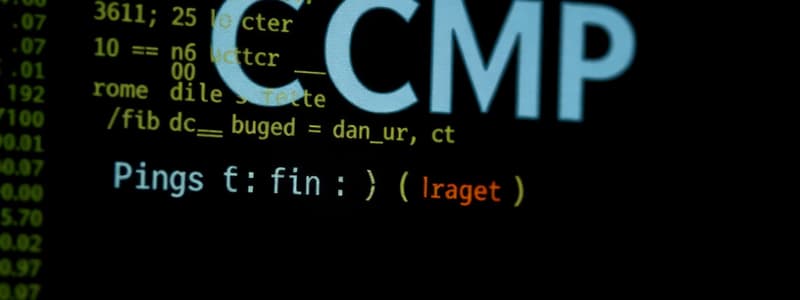Podcast
Questions and Answers
What is the main purpose of ICMP messages?
What is the main purpose of ICMP messages?
- To provide feedback about issues related to IP packet processing (correct)
- To improve network security by blocking packets
- To manage IP address allocation
- To ensure reliable delivery of IP packets
Which ICMP message is used to test the reachability of a host on an IP network?
Which ICMP message is used to test the reachability of a host on an IP network?
- ICMP Time Exceeded
- ICMP Echo Reply
- ICMP Echo Request (correct)
- ICMP Destination Unreachable
What happens when a host receives a packet that it cannot deliver?
What happens when a host receives a packet that it cannot deliver?
- It stores the packet for future delivery
- It sends an ICMP Destination Unreachable message to notify the source (correct)
- It automatically reroutes the packet to a different destination
- It drops the packet without any notification
Which of the following ICMP messages indicates that the time limit for a packet has been exceeded?
Which of the following ICMP messages indicates that the time limit for a packet has been exceeded?
Which ICMP version is specifically designed for IPv6?
Which ICMP version is specifically designed for IPv6?
What is the Destination Unreachable code for 'Host unreachable' in ICMPv4?
What is the Destination Unreachable code for 'Host unreachable' in ICMPv4?
Which ICMPv6 message is used for duplicate address detection?
Which ICMPv6 message is used for duplicate address detection?
What happens when a router receives a packet with a TTL of 0?
What happens when a router receives a packet with a TTL of 0?
How often does an IPv6 router send Router Advertisement messages?
How often does an IPv6 router send Router Advertisement messages?
Which of the following tools uses ICMP echo request and echo reply messages?
Which of the following tools uses ICMP echo request and echo reply messages?
What does a successful ping to the default gateway indicate?
What does a successful ping to the default gateway indicate?
Which protocol is used for reliable transmission of data between applications?
Which protocol is used for reliable transmission of data between applications?
What does the round-trip time (RTT) represent in a traceroute operation?
What does the round-trip time (RTT) represent in a traceroute operation?
What happens if a device does not respond to a ping request?
What happens if a device does not respond to a ping request?
How does the transport layer handle multiple applications communicating simultaneously?
How does the transport layer handle multiple applications communicating simultaneously?
What does UDP lack compared to TCP?
What does UDP lack compared to TCP?
Which application is best suited for using UDP?
Which application is best suited for using UDP?
What is the main role of the source port in TCP and UDP communications?
What is the main role of the source port in TCP and UDP communications?
Which of the following is NOT a field in the UDP header?
Which of the following is NOT a field in the UDP header?
What is a key feature of a stateless protocol like UDP?
What is a key feature of a stateless protocol like UDP?
What is the primary advantage of using UDP for real-time applications?
What is the primary advantage of using UDP for real-time applications?
Which protocol is preferred for applications that need assured delivery of data?
Which protocol is preferred for applications that need assured delivery of data?
Which of the following is NOT a function provided by TCP?
Which of the following is NOT a function provided by TCP?
What does the sequence number in a TCP header do?
What does the sequence number in a TCP header do?
What feature of TCP helps manage network resource limitations during data transmission?
What feature of TCP helps manage network resource limitations during data transmission?
What is the main responsibility of the transport layer?
What is the main responsibility of the transport layer?
How does the transport layer manage multiple communications?
How does the transport layer manage multiple communications?
What distinguishes TCP from UDP?
What distinguishes TCP from UDP?
What type of applications would benefit the most from using UDP?
What type of applications would benefit the most from using UDP?
Which of the following best describes UDP?
Which of the following best describes UDP?
Flashcards
Pinging 127.0.0.1
Pinging 127.0.0.1
Pinging a device's own IP address (127.0.0.1) is a way to check if TCP/IP is installed and functioning correctly on that device.
Pinging Default Gateway
Pinging Default Gateway
Pinging the default gateway address checks connectivity between your device and your router.
Pinging a Remote Host
Pinging a Remote Host
Pinging a remote host tests whether your device can communicate across different networks, reaching a destination outside your local network.
Traceroute
Traceroute
Signup and view all the flashcards
TCP
TCP
Signup and view all the flashcards
Data Segmentation
Data Segmentation
Signup and view all the flashcards
Transport Layer
Transport Layer
Signup and view all the flashcards
Port Number
Port Number
Signup and view all the flashcards
TCP (Transmission Control Protocol)
TCP (Transmission Control Protocol)
Signup and view all the flashcards
UDP (User Datagram Protocol)
UDP (User Datagram Protocol)
Signup and view all the flashcards
ICMPv4 Time Exceeded Message
ICMPv4 Time Exceeded Message
Signup and view all the flashcards
ICMPv6 Messages
ICMPv6 Messages
Signup and view all the flashcards
Router Solicitation (RS) message
Router Solicitation (RS) message
Signup and view all the flashcards
Router Advertisement (RA) message
Router Advertisement (RA) message
Signup and view all the flashcards
Neighbor Solicitation (NS) message
Neighbor Solicitation (NS) message
Signup and view all the flashcards
ICMP Echo Request
ICMP Echo Request
Signup and view all the flashcards
ICMP Destination Unreachable Message
ICMP Destination Unreachable Message
Signup and view all the flashcards
Internet Control Message Protocol (ICMP)
Internet Control Message Protocol (ICMP)
Signup and view all the flashcards
ICMPv4 and ICMPv6
ICMPv4 and ICMPv6
Signup and view all the flashcards
ICMP Optional
ICMP Optional
Signup and view all the flashcards
What is TCP?
What is TCP?
Signup and view all the flashcards
What is UDP?
What is UDP?
Signup and view all the flashcards
How does TCP establish a session?
How does TCP establish a session?
Signup and view all the flashcards
How does TCP ensure reliable delivery?
How does TCP ensure reliable delivery?
Signup and view all the flashcards
What are the key components of the TCP header?
What are the key components of the TCP header?
Signup and view all the flashcards
Socket
Socket
Signup and view all the flashcards
Study Notes
ICMP Protocol
- ICMP (Internet Control Message Protocol) is used for error and informational messages in the TCP/IP suite.
- ICMP messages are not required for IP reliability.
- ICMP is used for both IPv4 and IPv6. ICMPv4 is for IPv4, and ICMPv6 for IPv6.
- ICMP messages include:
- Host reachability (e.g., Ping)
- Destination/Service Unreachable (e.g., code 0 - Net unreachable, 1 - Host unreachable)
- Time Exceeded (related to packet TTL/Hop Limit expiration)
Ping Command
- Ping uses ICMP echo request/reply messages to test host connectivity.
- Pinging the loopback address (127.0.0.1 for IPv4, ::1 for IPv6) checks IP stack functionality.
- Pinging the default gateway checks local network connectivity.
- Pinging a remote host verifies internetwork communication.
- Timeout values may indicate security restrictions or network issues.
Traceroute Command
- Traceroute (tracert) generates a list of hops in a path.
- Traceroute utilizes the TTL/Hop Limit field in IP headers along with ICMP Time Exceeded messages.
- Round-trip time (RTT) for each hop is reported. Asterisks (*) indicate lost packets.
- Traceroute helps diagnose problems in the network path.
Transport Layer Protocols
- Transport layer protocols (TCP and UDP) facilitate host-to-host data transport.
- TCP is like a registered letter—reliable, connection-oriented, and sequenced.
- UDP is like a stamped letter—faster, less reliable, connectionless.
- Each data stream between two applications is tracked separately by the transport layer.
- Data is segmented/reassembled into segments/datagrams depending on the protocol.
- Header information (e.g., source/destination port numbers, sequence numbers, acknowledgment numbers) enable tracking.
- Port numbers identify applications on each host.
- Multiplexing allows multiple conversations to share network resources.
TCP
- Connection-oriented, reliable protocol
- Establishes a session before data transmission.
- Tracks data segments, acknowledges receipt, and resends lost segments.
- Sequences data for correct reassembly.
- Supports flow control (window size) to prevent overloading receivers.
- Uses a three-way handshake to establish a connection
- Uses a four-way handshake to terminate a connection.
- Provides a guaranteed and ordered delivery
- Includes features like selective acknowledgment (SACK)
- Overhead of 20 bytes for each segment
UDP
- Connectionless, best-effort protocol.
- No session establishment or acknowledgments.
- Data packets are not sequenced and resend lost segments.
- Primarily used for applications that can tolerate some data loss (e.g., streaming)
- Lower overhead than TCP.
- Overhead of 8 bytes per datagram
Application Layer
- The upper three layers of the OSI model (application, presentation, and session) are part of the TCP/IP application layer.
- Protocols define formats and control for common internet communication.
- Application protocols must be compatible for successful communication.
- Many protocols exist (e.g., HTTP, FTP, TFTP, IMAP, DNS).
DNS
- Translates domain names (e.g., cisco.com) to IP addresses.
- Hierarchical system with different zones for server responsibilities.
- Utilizes resource records (e.g., A, NS, AAAA) that store name and address mappings.
- DNS clients store previously resolved names in memory.
- The
nslookupcommand is used for manual name resolution queries
DHCP
- Automatically assigns IP addresses, subnet masks, gateways, and other network parameters.
- DHCP servers dynamically assign addresses from a pool.
- Leases for allocated addresses are temporary.
- Used for dynamically changing user populations and larger networks.
FTP
- Protocol for transferring files.
- Uses TCP ports 20 (data) and 21 (control).
- Clients can upload/download files from the server.
SMB
- File-sharing protocol for Microsoft networks.
- Establishes long-term connections to access shared resources.
- Supports shared directories, files, printers, and ports.
Network Security
- Protecting networks from unauthorized access and threats is crucial.
- Threats involve information theft, data loss/manipulation, identity theft, and disruption of service.
- Vulnerabilities include technological, configuration, and policy weaknesses.
- Physical security (e.g., securing computer rooms, monitoring access) is important.
- Malware includes viruses, worms, and Trojan horses.
- Reconnaissance attacks include ping sweeps & port scans to identify vulnerable resources.
- Access attacks exploit vulnerabilities in authentication and other services.
- Denial-of-service attacks overload resources to prevent legitimate use.
Studying That Suits You
Use AI to generate personalized quizzes and flashcards to suit your learning preferences.




